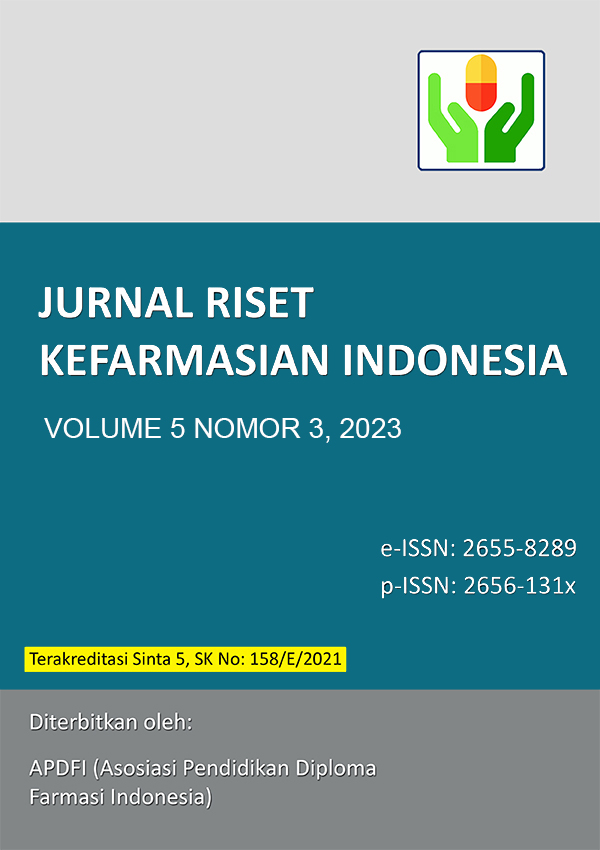RENDEMEN EKSTRAK ETANOL HERBA RUMPUT AKAR WANGI (Polygala paniculata L) PADA PERBANDINGAN KONSENTRASI PELARUT
DOI:
https://doi.org/10.33759/jrki.v5i3.418Keywords:
Rendemen, Polygala paniculata, etanol 70%, etanol 95%Abstract
Rumput akar wangi (Polygala paniculata (L)) belongs to the Polygalaceae family. One of the extract yields is influenced by solvent concentration. The aim of the research is to determine the effect of variations in concentration on the yield of Polygala paniculata extract and the groups of compounds in the extract. This research includes determination, collection, and plant preparation, processing of Polygala paniculata simplicia, extraction, screening, and determination of yield. In this study, 50 grams of Polygala paniculata powder were extracted with different solvent concentrations, namely 70% and 95% ethanol using the maceration method. Replication was carried out on each solvent three times. Data were analyzed using descriptive methods and processed using SPSS (Statistical Product and Service Solutions) tools. The results of phytochemical screening showed that the extract contained flavonoids, tannins, saponins, and terpenoids. The calculation results of the ethanol extract of Polygala paniculata were 70% ethanol (17.77% ± 1.34) and 95% ethanol (12.59% ± 0.86). The SPSS test results on the Independent Samples Test show that there is a significant difference (p < 0.05). The highest yield of Polygala paniculata extract was obtained using 70% ethanol for filtration.
Downloads
References
Departemen Kesehatan RI. 1995. Material Medika Indonesia Jilid VI. Jakarta: Depkes RI. Hal: 336
Departemen Kesehatan RI. 2000. Cara Pembuatan Simplisia. Jakarta: Depkes RI. Hal: 7-13
Departemen Kesehatan RI. 2000. Parameter Standar Umum Ekstrak Tumbuhan Obat. Cetakan Pertama. Depkes RI: Jakarta. Hal: 9, 11-12, 16
Heinrich, M., Barnes, J., Gibbons, S., Williamson, M. dan Elizabet. 2004. Fundamental of Pharmacognosy and Phytotherapi. Hungary: Elsevier. Hal: 144
Ivanisova, E.I., Damgaliev, D., Konstovo, M., 2013. “Antioxidant Activity Of Selected Plant Products”. Journal Of Microbiology, Biotechnology And Food Sciences.
Markham, K. R. 1988. Cara Mengidentifikasi Flavonoid. Terjemahan oleh Kosasih Padmawinata. Bandung : Penerbit ITB. Hal: 15
Pambayun, R., Garjdito,M., Sudarmadji, S., dan Kuswanto, K.R. 2007. “Kandungan Fenol dan Sifat Antibakteri dari Berbagai Jenis Ekstrak Produk Gambir (Uncaria Gambir roxb)”. Majalah Farmasi Indonesia. Yogyakarta. Hal: 141
Rijai, L. 2013. “Potensi Herba Tumbuhan Balsem (Polygala paniculata Linn) Sebagai Sumber Bahan Farmasi Potensial”. J. Trop. Pharm. Chem. 2 (2)
Saifudin, A., Rahayu, V., dan Teruna, H.Y. 2011. Standarisasi Bahan Obat Alam. Graha Ilmu: Yogyakarta.
Sari, W., 2012, “Kandungan Metabolit Sekunder dan Potensi Sitotoksik Ekstrak Herba Tumbuhan Balsem (Polygala paniculata)” Skripsi. Samarinda: Fakultas Farmasi. UNMUL.
Tiwari, P., Kumar, B., Kaur, M., Kaur G. & Kaur H., 2011. “Phytochemical Screening And Extraction”: A Review, International Pharmaceutica Sciencia, 1 (1), 98-106.
Voight. R. 1995. Buku Pelajaran Teknologi Farmasi. Edisi kelima. Jogjakarta: Gadjah Mada Universitas Press. Hal: 577-578
Downloads
Published
Issue
Section
License
Copyright (c) 2023 Jurnal Riset Kefarmasian Indonesia

This work is licensed under a Creative Commons Attribution-NonCommercial-ShareAlike 4.0 International License.












